
Lipid Biochemistry second stage lecture 1 Dr.Thana Alsewedy
1
DIGESTION OF LIPIDS
The major dietary lipids are triacyl glycerol, cholesterol and phospholipids.
Digestion in Stomach
Diet contains triglycerides, cholesterol and its ester, phospholipids, fattyacids
etc.Mouth and gastric juice has got lipase. It can hydrolysis fats without
emulsification with bile salts .Milk fat and butter fat is digested by this enzyme.
The lingual lipase from the mouth enters stomach along with the food. It has
an optimum pH of 2.5-5).The enzyme, therefore, continues to be active in
the stomach. It acts on short chain triglycerides(SCT). SCTs are present in
milk, butter and ghee.The action of lingual lipase is observed to be more
significant in the newborn infants. Gastric lipase is acid stable, with an
optimum pH around 5.4. It is secreted by chief cells, the secretion is
stimulated by gastrin. Up to 30% digestion of triglycerides occurs in stomach.
Digestion in Intestines
Emulsification is a prerequisite for digestion of lipids. The lipids are
dispersed into smaller droplets;surface tension is reduced; and surface area
of droplets is increased. This process is favored by:
1. Bile salts (detergent action)
2. Peristalsis (mechanical mixing)
3. Phospholipids
Bile Salts are Important for Digestion of Lipids
The bile salts present in the bile (sodium glycocholate and sodium
taurocholatea synthesized in the liver as a derivative of cholesterol. theylower
surface tension and emulsify the fat droplets. The emulsification increases
the surface area of the particles for enhanced activity of enzymes
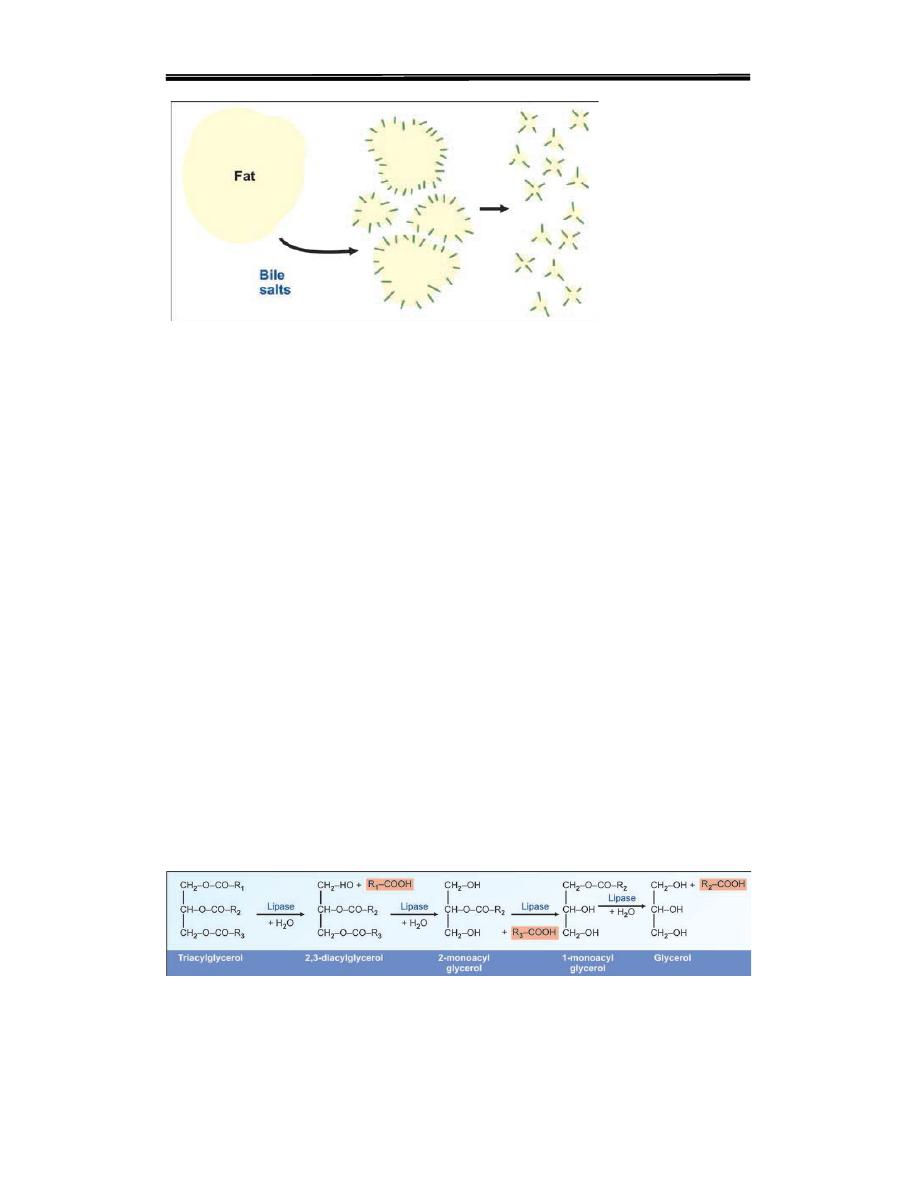
Lipid Biochemistry second stage lecture 1 Dr.Thana Alsewedy
2
.
Fig. 11.2. Action of bile salts. The hydrophobic portions of bile salts
intercalate into the large aggregated lipid, with the hydrophilic domains
remaining at the surface. This leads to breakdown of large aggregates into
smaller and smaller droplets. Thus, the surface area for action of lipase
is increased
Digestion of Triglycerides
Major part of fats are digested by pancreatic lipase
Pancreatic lipase can
easily hydrolyse the fatty acids esterified to the 1st and 3rd carbon atoms of
glycerol forming 2-monoacylglycerol and two molecules of fatty acid
Pancreatic lipase hydrolysis
1-triglycerides (TG) hydrolyzed by pancreatic lipase
TG + H2O → diglyceride + fatty acid (FA)
diglyceride + H2O → monoglyceride (MG) + FA
Fig. 11.1. Complete hydrolysis of triglyceride. In the intestines,
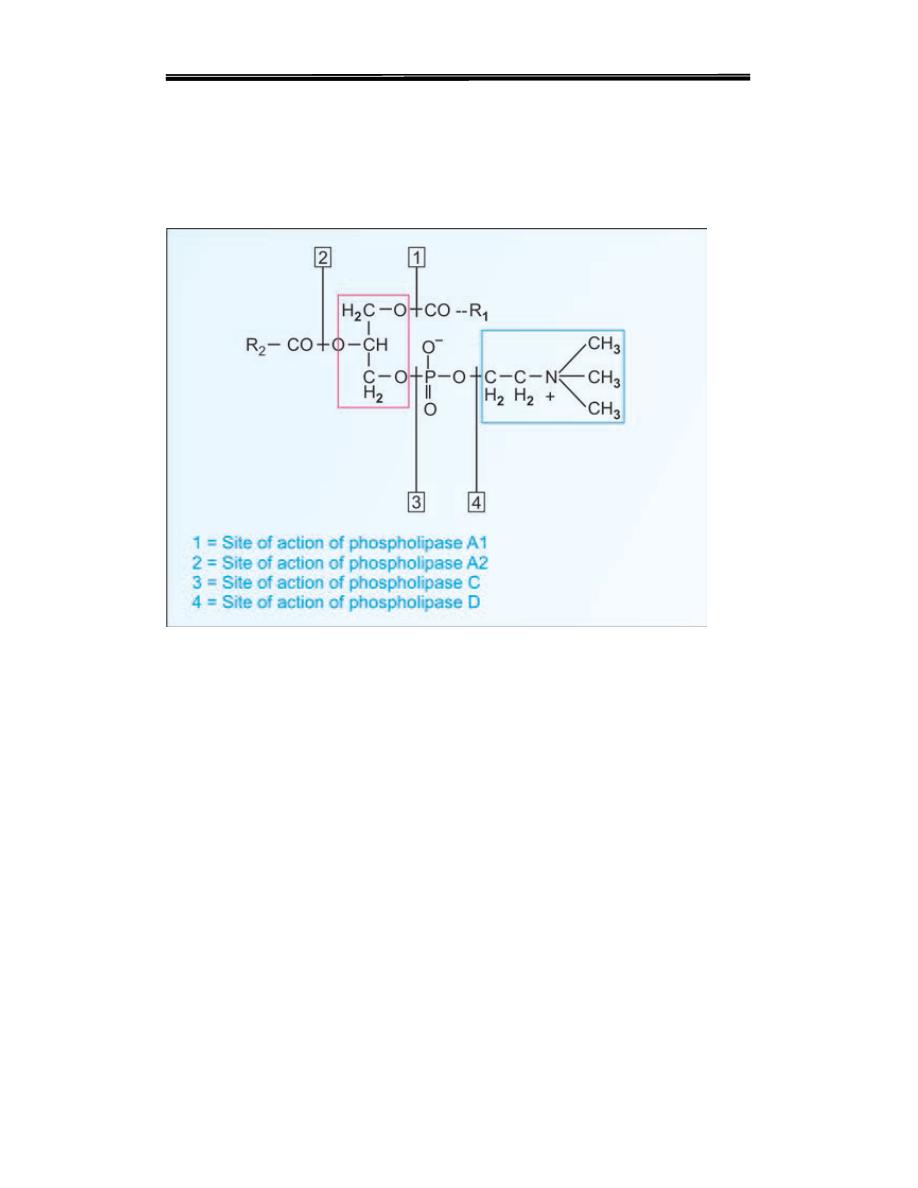
Lipid Biochemistry second stage lecture 1 Dr.Thana Alsewedy
3
2-phospholipids hydrolysed by Phospholipase A1 and A2 Hydrolyzes
fatty acids from phospholipids
3-Cholesterol esterase
Hydrolyzes fatty acids from cholesterol esters
cholesterol esters & phospholipids* (PL)
↓ esterase
↓ phospholipases
FA + cholesterol (chol) FA + lysoPL
Co-lipase
Pancreatic lipase is characterized by increased activity against water-
insoluble substrates and by dependence on another protein, colipase, for
binding to the substrate interface. So to increase pancreatic lipase
activity,needing colipase functions to anchor lipase on the substrate
interface.
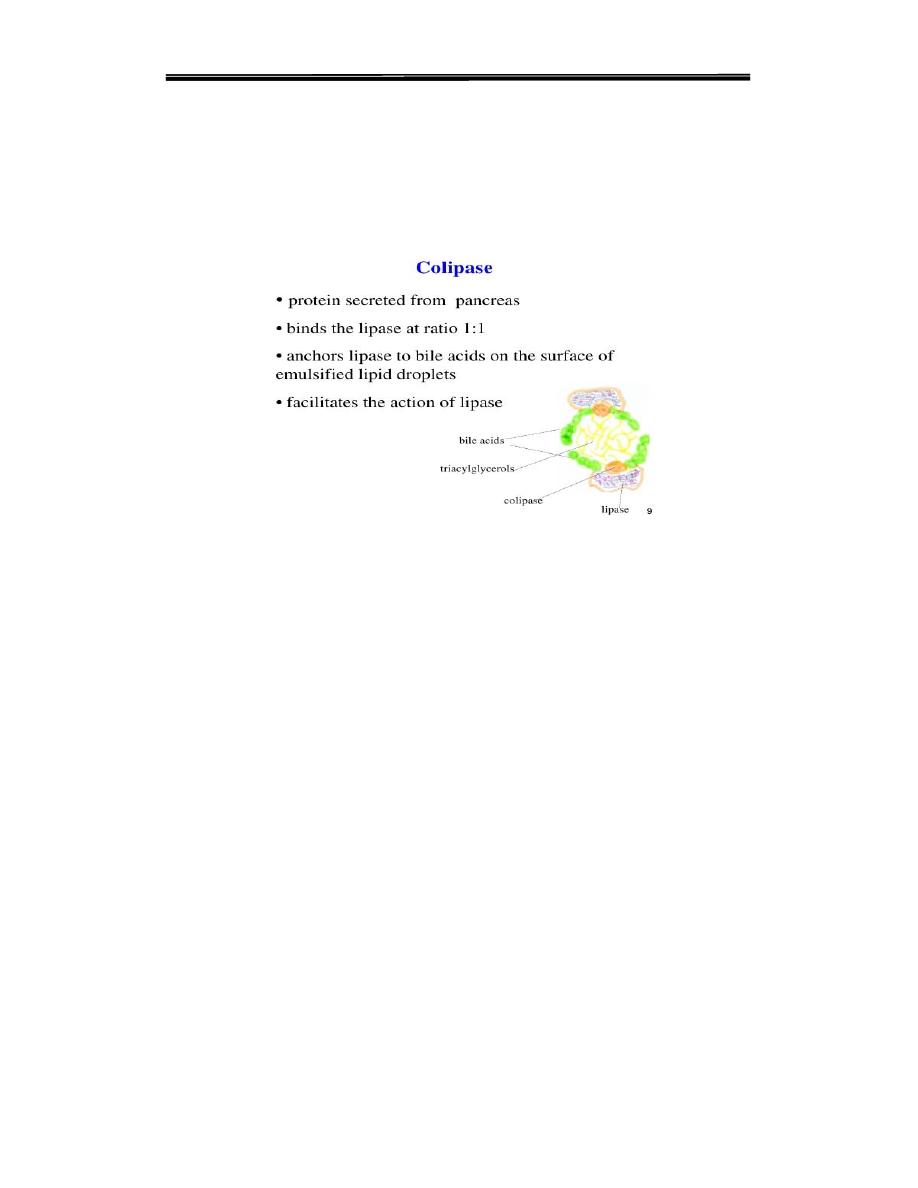
Lipid Biochemistry second stage lecture 1 Dr.Thana Alsewedy
4
The binding of co-lipase to the triacyl glycerol molecules at the oil water
interface is obligatory for the action of lipase. The co-lipase is secreted by the
pancreas as an inactive zymogen (molecular weight 11,000). It is activated by
trypsin.
ABSORPTION OF LIPIDS
Absorption of Long Chain Fatty Acids
Long chain fatty acids (chain length more than 14 carbons) are absorbed to
the lymph and not directly to the blood. And has the following steps.
1. Mixed Micelle Formation
i. The products of digestion, namely 2-monoglycerides,long chain fatty acids,
cholesterol, phospholipids and lysophospholipids are incorporated into
molecular aggregates to form mixed micelle (Fig. 11.3). The micelles are
spherical particles with a hydrophilic exteriorand hydrophobic interior core .
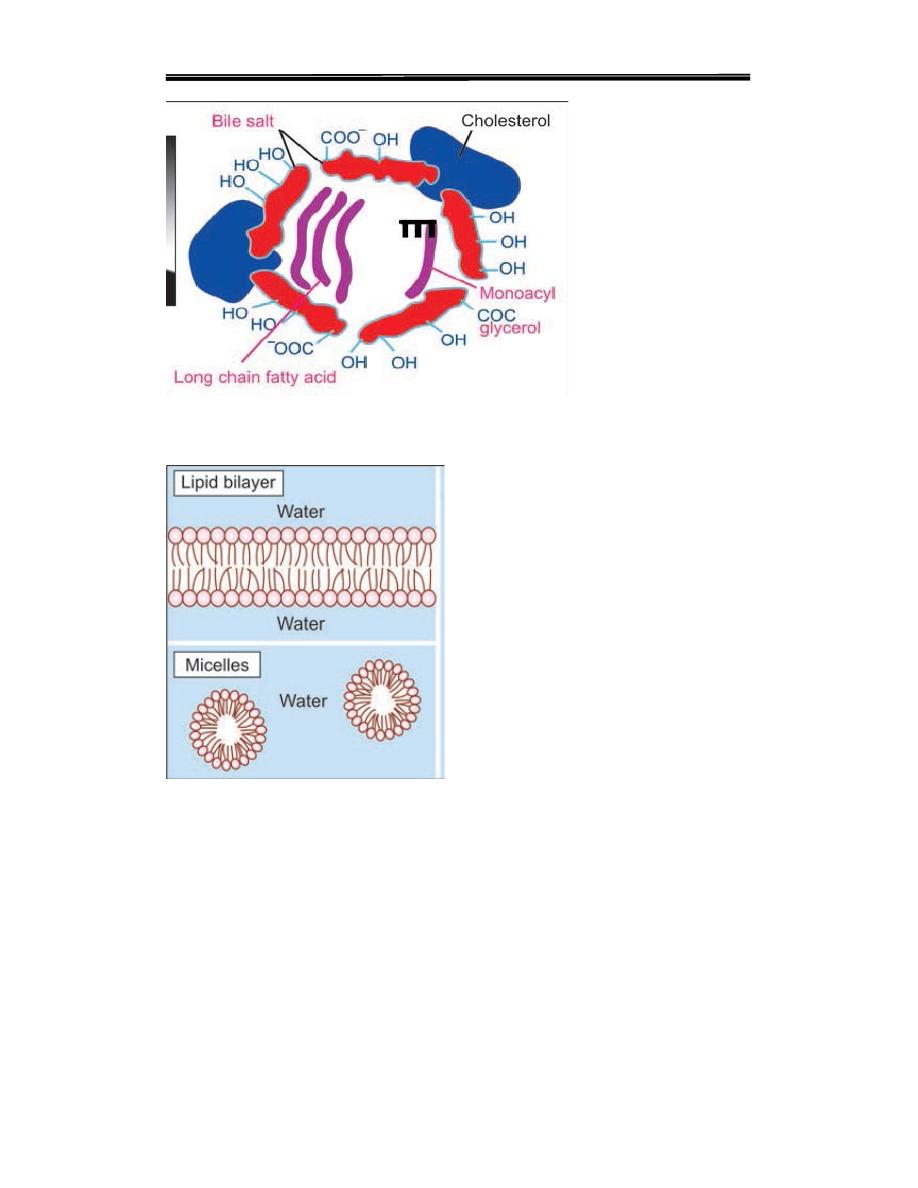
Lipid Biochemistry second stage lecture 1 Dr.Thana Alsewedy
5
Fig. 11.3. Micellar formation
Phospholipids form micelles
Due to their detergent action, the bile salts help to form micellar aggregates
(Fig. 11.2).
ii. Micellar formation is essential for the absorption of fat-soluble vitamins
such as vitamin A,D and K.
iii. The micelles are aligned at the microvillous surface of the jejunal
mucosa. Fatty acids, 2-MAG and other digested products passively
diffuse into the mucosal cell (Fig. 11.4).
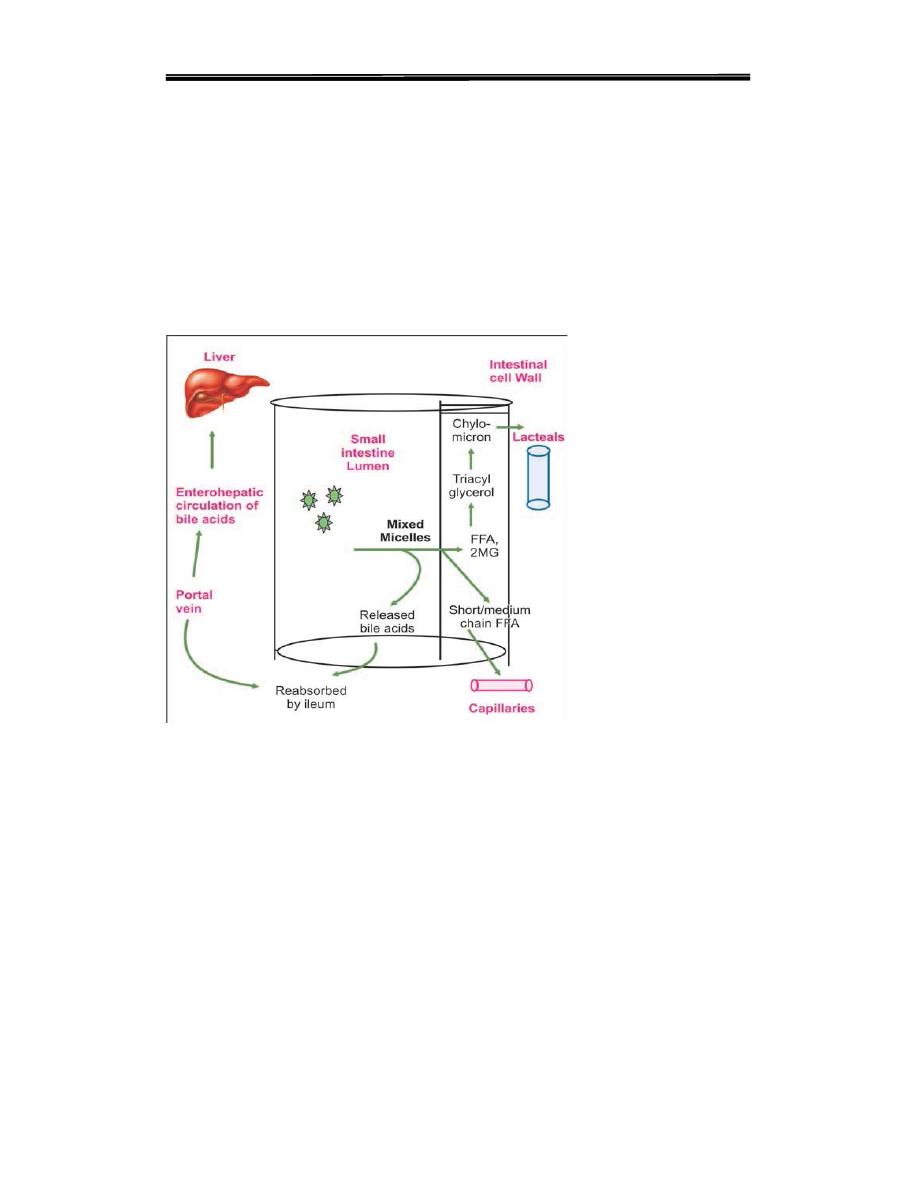
Lipid Biochemistry second stage lecture 1 Dr.Thana Alsewedy
6
2. Enterohepatic Circulation of Bile Salts
The bile salts are left behind which are mostly reabsorbed from the ileum and
returned to the liver to be re-excreted (enterohepatic circulation). About
98% of dietary lipids are normally absorbed
3. Re-esterification Inside the Mucosal Cell
i. Once inside the intestinal mucosal cell, the long chain fatty acids are re-esterified
to form triglycerides (Fig. 11.5).
ii. The fatty acids are first activated to fatty acyl
CoA by the enzyme, acyl CoA synthetase orthiokinase This needs lysis of
two high energy bonds.
iii. Two such activated fatty acids react with monoacyl glycerol (MAG) to form
the triglyceride. Majority of molecules follow this MAG pathway
iv. Free glycerol absorbed from intestinal lumen directly enters into the
bloodstream. So free glycerol is not available for re-esterification. But the cells
can convert glucose to glycerol phosphate, and then add 3 molecules of acyl
groups to synthesize TAG
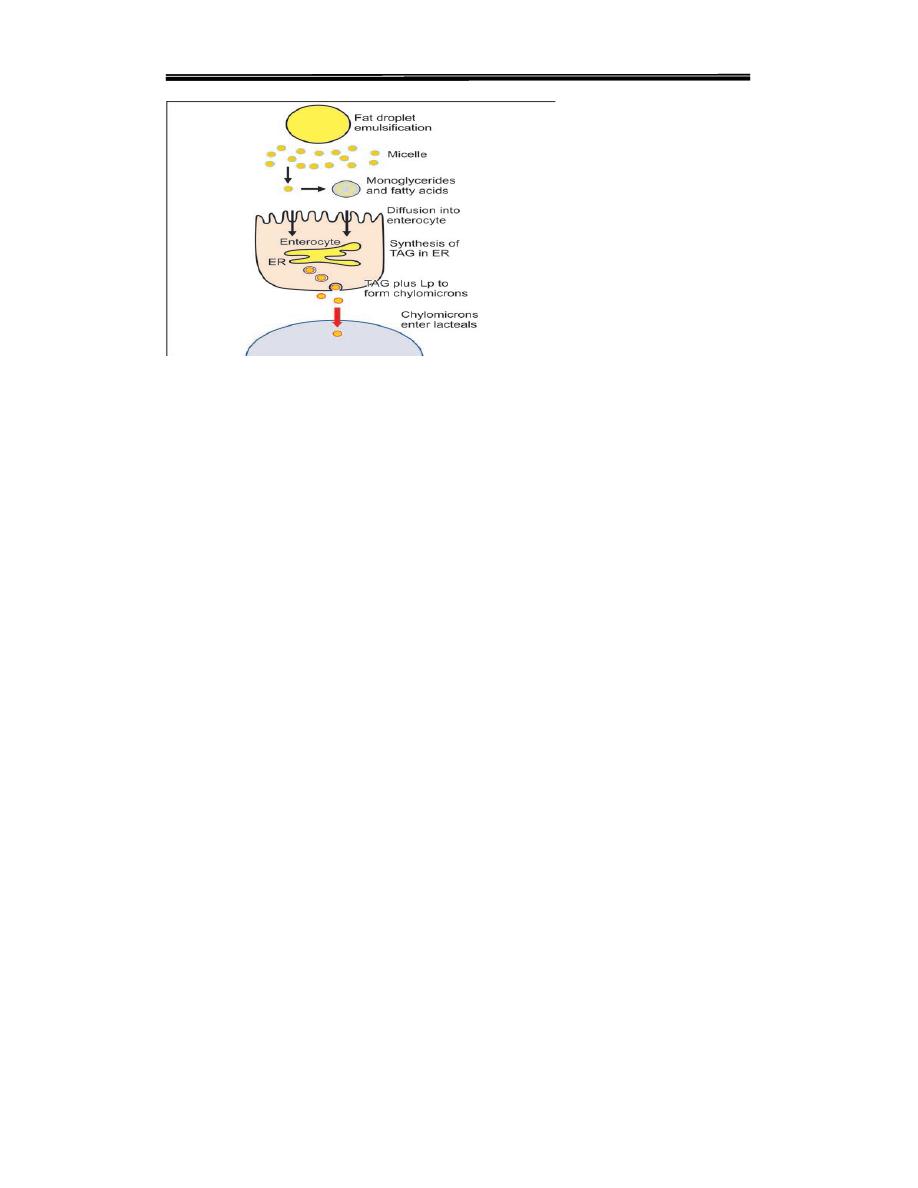
Lipid Biochemistry second stage lecture 1 Dr.Thana Alsewedy
7
11.4. Absorption of fat as chylomicrons. This
needs the help of bile salts
3. Chylomicrons
The TAG, cholesterol ester and phospholipids molecules along with apoproteins
B48, and apo-A are incorporated into chylomicrons The chyle (milky fluid) from the
intestinal mucosal cells loaded with chylomicrons are transported through the
lacteals into the thoracic duct and then emptied into lymph circulation The serum
may appear milky after a high fat meal (postprandial lipemia) due to the presence of
chylomicrons incirculation. Normally the lipemia clears within a few hours by the
uptake of chylomicrons by tissues. The major steps of lipid absorption are shown in
Box11.1.
Box 11.1. Six Steps of Lipid Absorption
1. Minor digestion of triacylglycerols in mouth and
stomach by lingual (acid-stable) lipase.
2. Major digestion of all lipids in the lumen of the duodenum/jejunum by
pancreatic lipolytic enzymes.
3. Bile acid facilitated formation of mixed micelles.
4. Passive absorption of the products of lipolysis from the mixed micelle into
the intestinal epithelial cell.
5. Reesterification of 2-monoacylglycerol with free fatty acids inside the
intestinal enterocyte.
6. Assembly of chylomicrons containing Apo B48, triacylglycerol, cholesterol
esters and phospholipids and export from intestinal cells to the lymphatics.
5. Abnormalities in Absorption of Lipids

Lipid Biochemistry second stage lecture 1 Dr.Thana Alsewedy
8
1. Defective digestion: In steatorrhea, daily excretion of fat in feces is more
than 6 g per day. (Greek word, "stear", means fat). It is due to chronic
diseases of pancreas In pancreatic deficiency. In such cases, unsplit fat is
seen in feces
2. Defective absorption: On the other hand, if the absorption alone is
defective, most of the fat in feces may be split fat, i.e. fatty acids and
monoglycerides . When bile is not availablecause Defective absorptionand
thislead to defect absorbtion of vitamin K leads to prolonged prothrombin
time.
